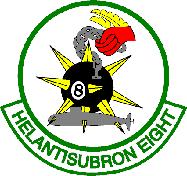

107: ARMAMENT FUNDAMENTALS
SH/HH-60F/H EAWS SPECIFIC
1. Define the term pyrotechnics.
Pyrotechnics are fireworks adapted to military use. The word pyrotechny means the art of fire. Therefore, pyrotechnics are items that produce their effect by burning, and are consumed in the process. Pyrotechnics, as used in the military, are items that produce a bright light for illumination or colored lights or smoke for signaling.
2. State the purpose and burn time of the following pyrotechnics:
a. MK 80 MOD O signal flare:
The Mk 79 Mod 0 signal kit consists of a Mk 31 Mod 0 signal projector, a plastic bandoleer that holds seven Mk 80 Mod 0 signals, and an instruction sheet. The kit is used by downed aircrew personnel as a distress-signaling device. Because it is small and lightweight, personnel can carry it in pockets of flight suits or in life rafts. The projector aims and fires the signals. Each signal contains a single red star. On activation, this star is propelled upward to a height of between 250 and 650 feet. The star burns for a minimum of 4 1/2 seconds.
b. MK 124 MOD O signal:
The Mk 124 Mod 0 is used as a day or night signal by personnel on land or sea. Because of its small size and weight, it can be carried in life vests or flight suit pockets and on life rafts. This device is especially adapted for use by aircrew personnel downed at sea. It has two sides, one for day (produces orange smoke) and one for night (red flame), both side last approx. 20 seconds.
c. MK 25 MOD 4 Marine location Marker:
They are launched from aircraft to provide day or night reference points for marking the course of enemy submarines in antisubmarine warfare operations. They are suitable for any type of sea-surface reference-point marking that calls for both smoke and flame for a period of 10 to 20 minutes.
d. MK 58 MOD O marine location marker:
They are launched from aircraft to provide day or night, long burning reference point marking on the ocean surface. It is also used for SAR operation, man overboard, and as a target for practice bombing at sea (40 to 60 minutes).
3. State the purpose of explosive handling personnel qualification and certification program.
To set guidelines for weapons certification for all personnel whose duties require evolutions or tasks involving explosive device.
4. State the purpose of the airborne weapons stores loading manual.
To standardize loading procedures used throughout the Navy and Marine Corps, improving safety and reliability in the loading of conventional weapons and airborne stores.
5. Define the following sonobouy classifications:
Self-timed or commandable sonobuoy in which the sonar signal that pulses is used for a target range movement. These signals are transmitted by the ASW aircraft for processing and display.
b. Passive-
Detects underwater sounds and converts them to electrical energy transmits a signal to a receiving station, normally on the deployment aircraft.
c. Special Purpose-
To measure water temp verses depth, or for communication from aircraft to submarine.
Provide a standard system for reporting malfunctions or induced defects involving live ordnance, ammunition, explosives, explosive systems and devices such as bomb racks, missile launchers, gun systems, rocket launcher, sonobouy launchers, leaking or spilled OTTO fuel, and armament weapons support equipment.
b. Explosive mishap Report (EMR)-
a report that applies to explosive incidents involving conventional ordnance, ammunition, explosives, explosive system and devices resulting in actual unintentional detonation, firing, burning, launching of ordnance material leaking of spilled propellant fuels and oxidizers, or chemical agents released.
It issues the policies, procedures and responsibilities for activities supporting or performing airborne weapons maintenance.
8. Explain the conditions for aircraft grounding during weapons load/unload.
During aircraft explosive loading/downloading procedures, the aircraft shall be grounded such that the resistance between aircraft and ground shall be 10,000 ohms or less.
9. State the purpose of a stray voltage check.
Stray voltage checks are normally performed with the weapon loaded on the aircraft, but they are made before making an electrical connection between the weapon and the aircraft. Additionally, this check is normally performed after the aircraft’s engines have been started and all aircraft preflight checks have been completed. The stray voltage check is performed at the last possible moment before the aircraft takes off. This is to ensure that no voltage has been induced in the aircraft firing circuitry from external sources, such as the ship’s radar. The launcher electrical safety pin must not be removed until the aircraft is positioned on the catapult for takeoff.
10. State the purpose of the explosive ordnance disposal EOD unit.
Personnel with special training and equipment who render explosive ordnance safe, make intelligence reports, and supervise the safe removal of ordnance.
11. State the purpose of the hazards of electromagnetic radiation to ordnance.
The functional characteristics of electrically initiated ordnance cause hazards of electromagnetic radiation to ordnance (HERO). Ordnance that presents a HERO problem includes cartridges, cartridge-actuated devices, and 20-mm ammunition. The ordnance electroexplosive devices (EEDs) may be accidentally initiated or their performance degraded by exposure to radio frequency (RF) environments. Ordnance is more susceptible to RF environments during assembly, disassembly, handling, loading, and unloading operations.
12. State the three categories of HERO susceptibility.
3. General HERO requirements are observed.
c. HERO UNSAFE:
An ordnance item is classified as HERO unsafe if it meets the following criteria:
AW1 Benjamin Kunz
kimberly.a.king@navy.mil
AZC(AW/NAC) Kimberly King